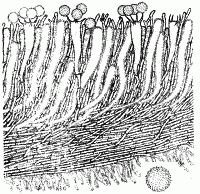|
 Aleurodiscus patelliformis Aleurodiscus patelliformis
BiostatusPresent in region - Indigenous. Endemic
Images (click to enlarge)
Caption: Pl. 24, fig. 2. Aleurodiscus patellaeformis, x 1. | 
Caption: Fig. 1. Aleurodiscus patellaeformis. Transverse section showing gloeocystidia and
pseudophyses, x 500. Spore, x 1000. |
Article: Cunningham, G.H. (1956). Thelephoraceae of New Zealand. Part XI. The genus Aleurodiscus. Transactions of the Royal Society of New Zealand 84(2): 237-268.
Description: Hymenophore annual, membranous, brittle when dry, pateriform or cupulate, attached by a
small central base, margins free, 2-10 mm diameter; exterior surface finely radiately villose,
tan or bay-brown; margin inturned, even, bay-brown; hymenial surface concave, even, cream
or pallid ochre. Context white, to 0.3 mm thick, composed of closely arranged parallel hyphae
radiating from the point of attachment, tinted towards the margins, intermediate layer
wanting; generative hyphae to 4 µ diameter, walls 0.5 µ thick, hyaline, branched, septate,
with clamp connexions. Hymenial layer to 130 µ deep, a close palisade of basidia,
paraphyses, pseudophyses and gloeocystidia. Basidia subclavate, 64-80 x 10-14 µ, 4-spored;
sterigmata arcuate, subulate, to 14 µ long. Paraphyses subclavate, about one-third the length
and diameter of the basidia. Pseudophyses filiform, slightly projecting, to 4 µ diameter,
apices rounded. Gloeocystidia arising from the base of the subhymenium, penetrating the
hymenium but not projecting, forming a dense palisade, flexuous-cylindrical, 110-160 x 10-16 µ. Spores globose or subglobose, 14-17 µ diameter, walls sparsely and coarsely aculeate,
0.5-1 µ thick, amyloid, spines to 2.5 µ long, tinted.
Habitat: HABITAT. Scattered on bark of dead branches.
Distribution: DISTRIBUTION. New Zealand.
Notes: Specific features are the small saucer-shaped pilei with exterior surfaces clothed in
downpressed hairs, brittle context; globose aculeate spores and large prominent gloeocystidia
forming a dense palisade. In its aculeate spores the species resembles A. amorphus. It differs
in that spores are of different shape, much smaller, gloeocystidia are present, and pilei larger
and of different shape.
Four species possess fructifications which are at first pateriform with upturned margins,
naked cylindrical pseudophyses and cylindrical gloeocystidia. Three are endemic and form a
small section which appears to be confined to this region. Pilei of A. patellaeformis and A.
pateriformis retain their pateriform shape. Those of A. parmuliformis and A. limonisporus
soon coalesce to form effused areas with peripheral margins upturned or plane. Each colony
is then indicated by ridges at points of coalescence (A. limonisporus), different lines of
colour, or crevices (A. parmuliformis).
|